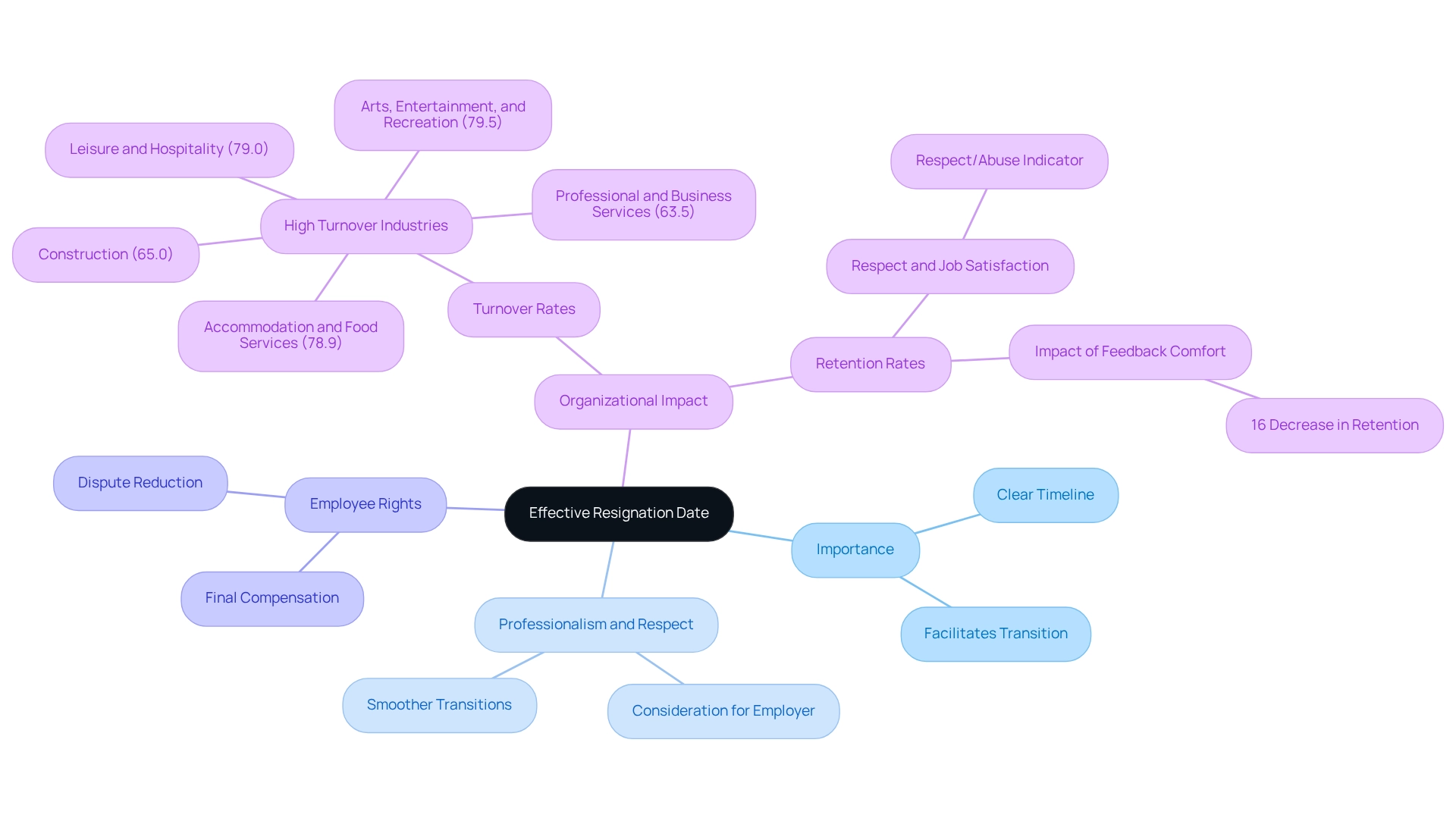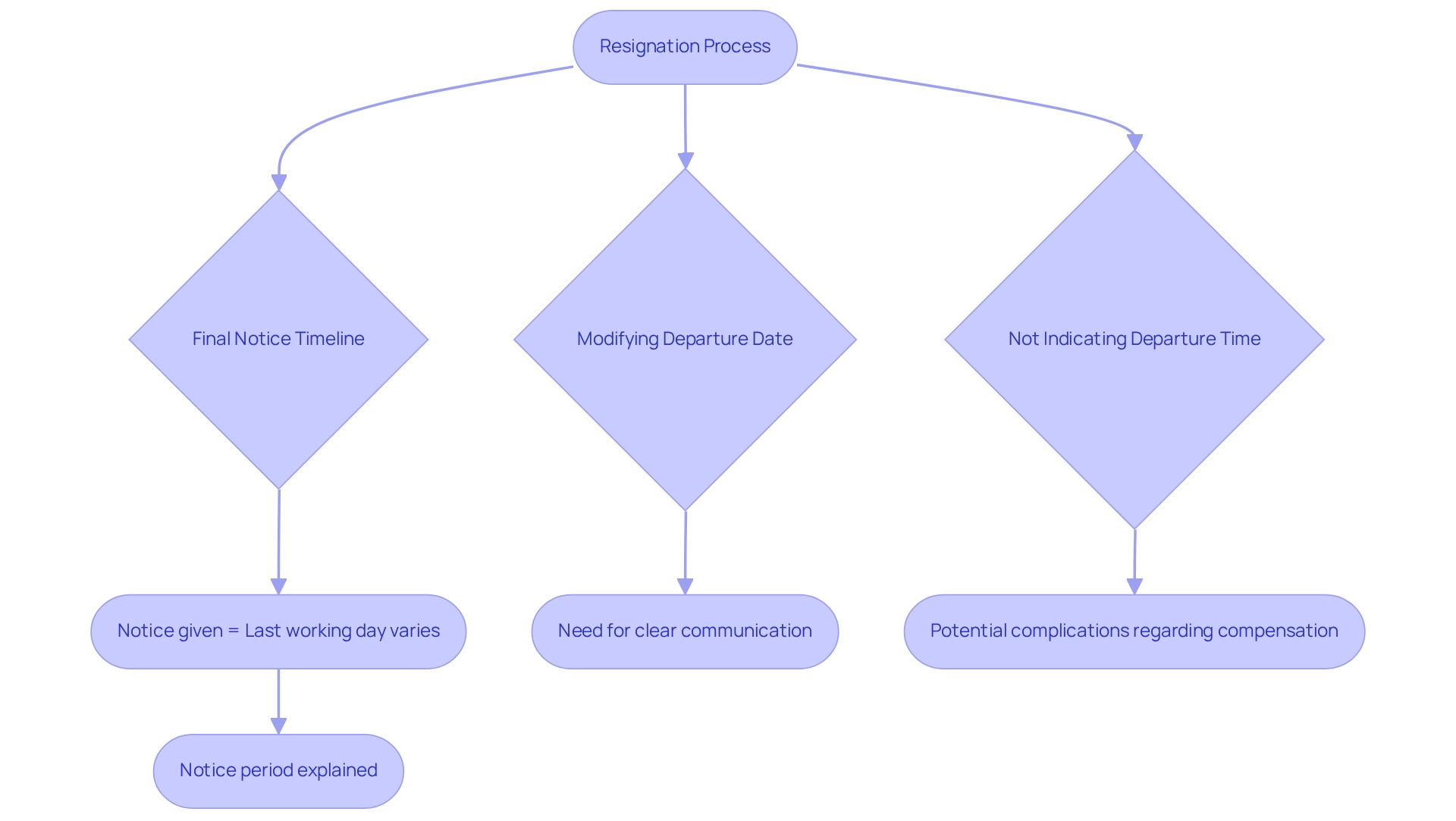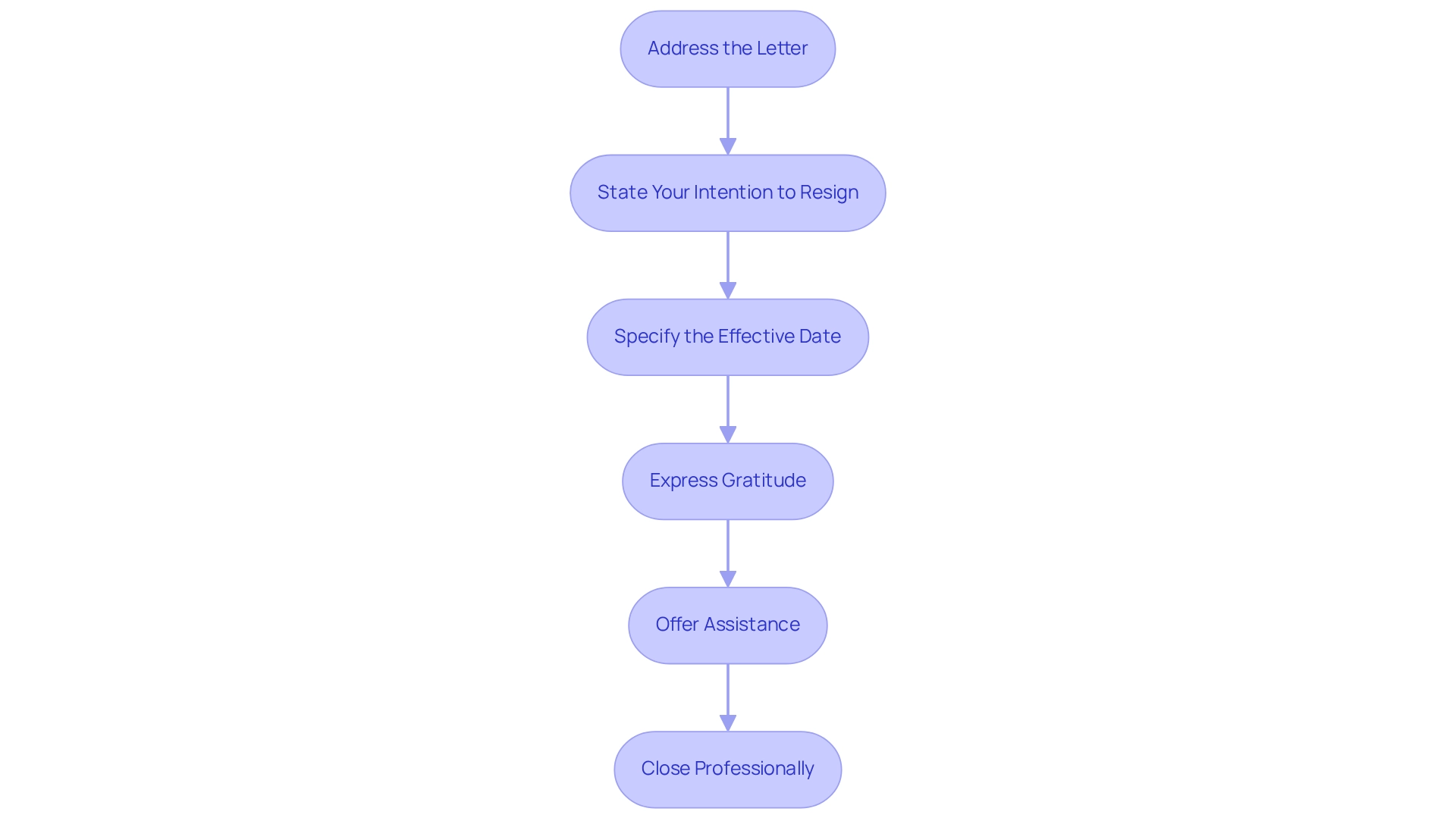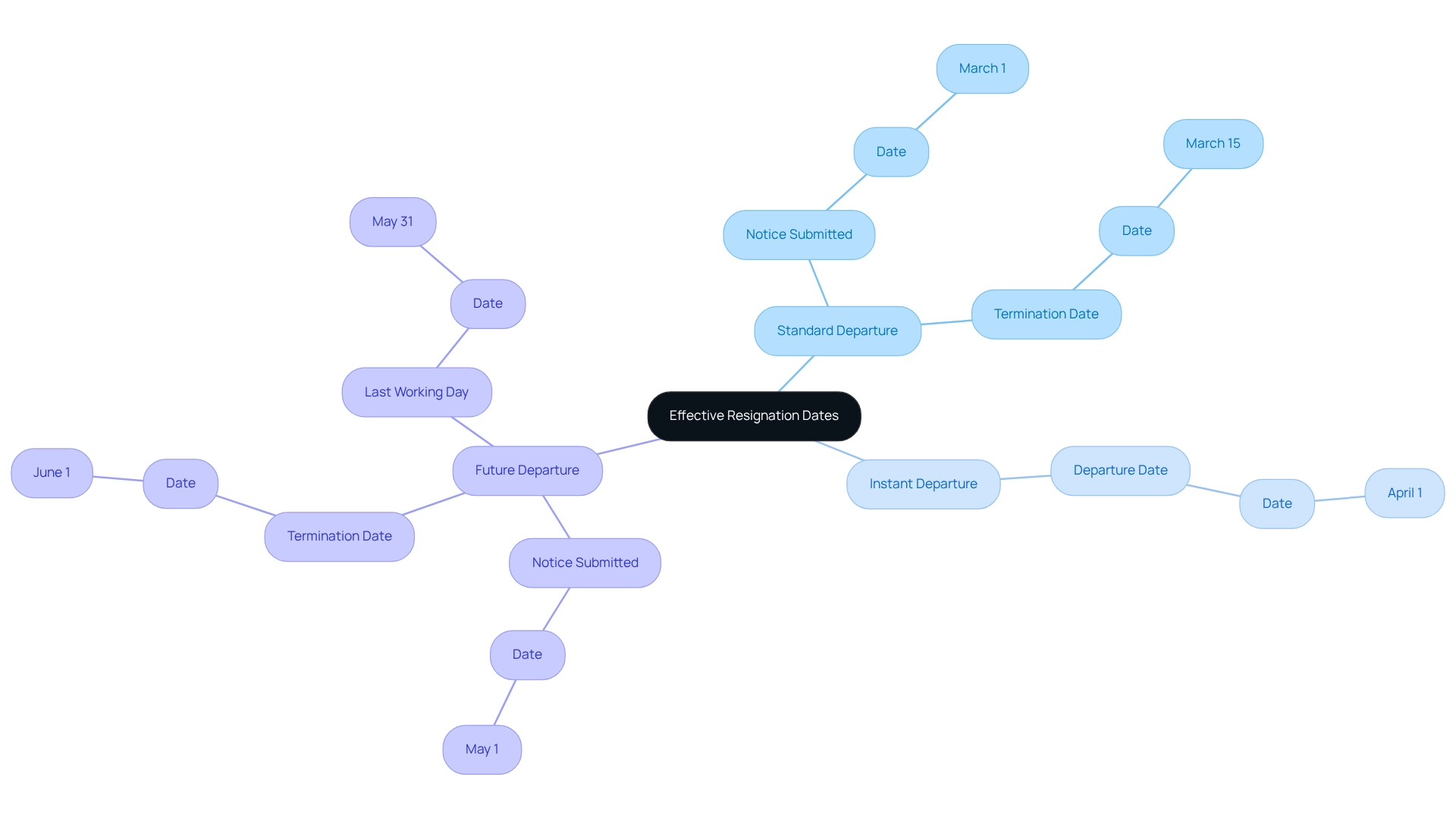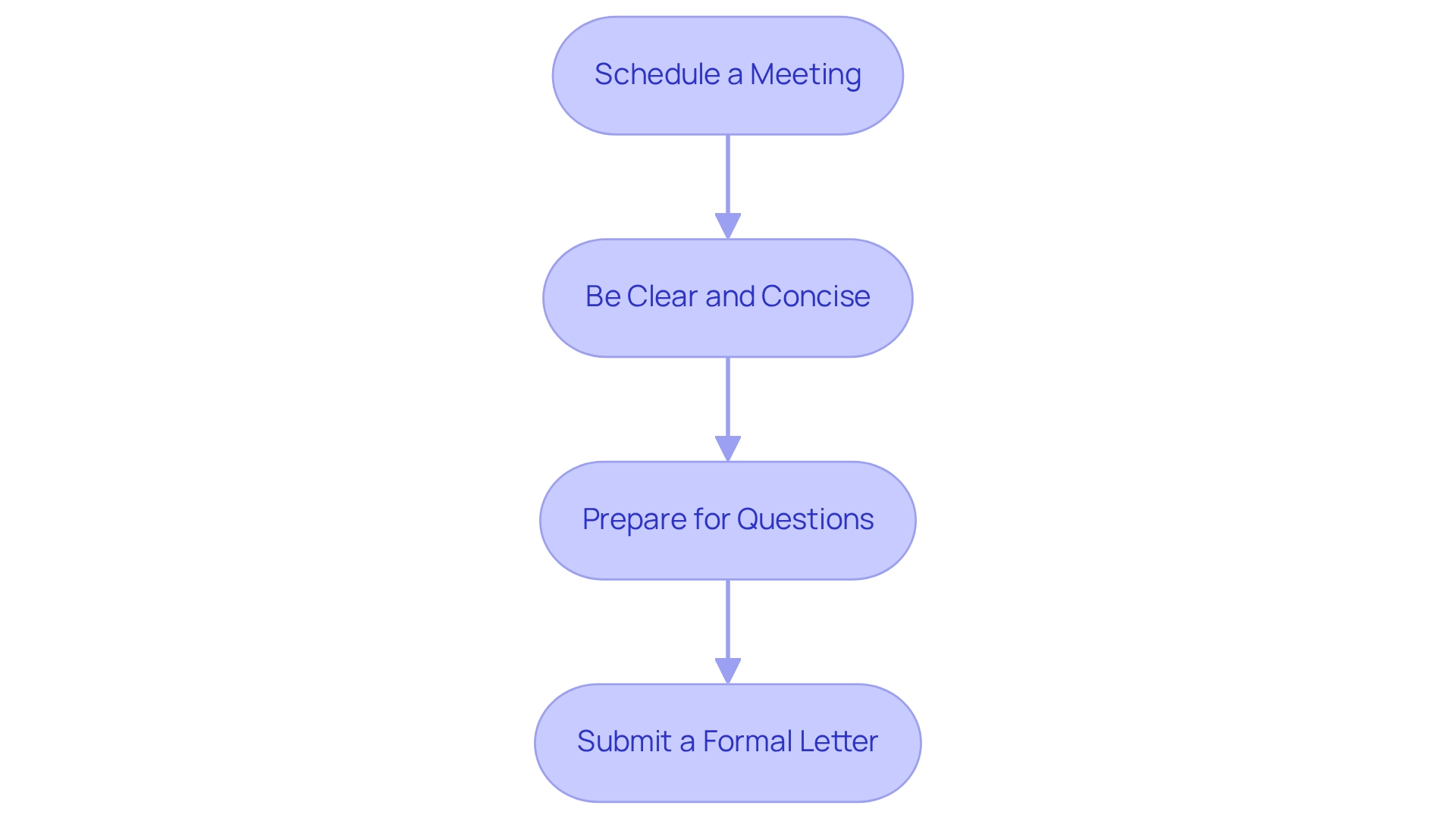Overview
The effective resignation date serves as the official marker of an employee’s formal resignation, signaling the conclusion of their employment. This date typically aligns with the notice period outlined in the employment agreement. It is imperative to communicate this date clearly to prevent misunderstandings, legal complications, and potential damage to professional reputation. Such clarity ensures a seamless transition for both the employee and employer, reinforcing the importance of this often-overlooked aspect of the resignation process.
Key Highlights:
- The effective resignation date marks the official end of employment, distinct from the notice submission date.
- It is crucial for both employees and employers to understand this date for smooth transitions.
- A typical scenario includes a two-week notice period, where the effective resignation date aligns with the notice period’s end.
- In a competitive job market, clear communication about departure timelines is essential for managing expectations.
- Failure to specify an effective resignation date can lead to misunderstandings, legal complications, and damage to professional reputation.
- The effective resignation date differs from the last working day; the former is when the resignation is official, while the latter is the final day worked.
- Employers benefit from clear resignation dates through better workforce management and reduced turnover rates.
- Best practices for writing a resignation letter include stating the effective date, expressing gratitude, and offering assistance during the transition.
- Communicating resignation effectively involves scheduling a meeting, being clear and concise, and preparing for potential questions.
Introduction
In the ever-evolving landscape of the modern workplace, understanding the nuances of resignation is increasingly critical. As employees navigate their career transitions, the concept of an effective resignation date emerges as a pivotal element in ensuring a smooth and professional exit. This date signifies not just the official end of an employment relationship, but also plays a crucial role in maintaining workplace harmony and safeguarding the interests of both parties. Given the fluctuating job markets and the rising trend of employee turnover, grasping the implications of effective resignation dates empowers individuals to make informed decisions about their career paths.
This article delves into the significance of specifying an effective resignation date, addresses common questions surrounding it, and outlines practical steps for crafting a resignation letter that upholds professionalism and clarity.
What is an Effective Resignation Date?
A crucial aspect of employment transitions is the effective resignation date—the precise moment when a worker’s departure becomes formal, marking the conclusion of their tenure with the organization. This date is typically noted in the departure letter and is vital for both the employee and employer to understand. It is essential to differentiate this from the submission date of the termination letter, as the actual end of employment usually aligns with the notice period outlined in the employment agreement.
Consider this scenario: a staff member submits their notice on April 1 with a two-week notification period. In this case, their effective resignation date would likely be April 15, unless alternative arrangements are made. The importance of the effective resignation date transcends mere logistics; it is pivotal for ensuring a smooth transition for both parties. In employment contracts, this date is often tied to the terms of the agreement, which may specify the required notice period.
Understanding this timeline is paramount, particularly in a competitive job market where candidates are encouraged to explore multiple job offers before making a decision. The total nonfarm quit rate has experienced significant fluctuations, nearly doubling from 1.6 percent to 3.0 percent between April 2020 and November 2021. Such statistics underscore the dynamic nature of job transitions and highlight the necessity for clear communication regarding departure timelines.
Moreover, case studies indicate that as labor market conditions tighten, the rates at which employees choose to leave tend to increase. This trend suggests that factors beyond mere contractual obligations influence the decision to depart, including personal circumstances and market dynamics. Thus, establishing an appropriate departure timeline is not just about compliance; it is a strategic consideration for workers contemplating their next career moves.
It is advisable to allow buffer time before commencing a new position to account for unforeseen circumstances or setbacks, thereby ensuring a smoother transition and enabling candidates to explore all available options that may better align with their long-term career aspirations.
In corporate settings, instances of suitable departure timelines can vary significantly, yet they typically correspond with standard notice periods of two weeks to one month, contingent upon the position and company policy. Grasping how to identify an effective resignation date necessitates an understanding of both contractual obligations and the practical implications of transitioning to a new role. As the workplace continues to evolve—with experts noting that the rise of artificial intelligence could enhance productivity and potentially lead to a four-day workweek—staying informed about these dynamics will empower individuals to navigate their departures effectively and make well-informed career choices.
Additionally, candidates should exercise caution against hastily committing to a job offer, as this may result in regret if they fail to explore all available options. A company that genuinely values its employees, such as Boutique Recruiting, will appreciate the importance of making a well-informed career decision. Future studies are also warranted to examine pandemic-related factors influencing quit rates, such as stimulus payments, health concerns, childcare challenges, and shifting perspectives on work, further emphasizing the necessity for strategic departure planning.
The Importance of Specifying an Effective Resignation Date
Indicating an effective resignation date in a resignation letter is essential for several reasons. Firstly, it establishes a clear timeline for both the worker and employer, facilitating effective planning and transition. This clarity is crucial in a competitive job market, where the average nonfarm quit rate rose by 1.4 percentage points from April 2020 to November 2021, underscoring the significance of structured transitions for workers.
Secondly, it fosters professionalism and respect within the workplace, demonstrating consideration for the employer’s need to find a replacement or redistribute responsibilities. Organizations that have established clear departure timelines have noted smoother transitions and enhanced retention rates, as staff feel more secure in their exit process.
Furthermore, possessing a recorded valid timestamp protects the worker’s rights concerning final compensation and benefits, reducing the likelihood of disagreements about when their employment formally ends. This is particularly important in industries with high turnover rates, such as leisure and hospitality, where the retention rates were notably low at 79.0% in 2019. The case study titled “Reasons for Workforce Turnover” highlights that common reasons individuals leave their jobs include poor management practices and lack of career development opportunities.
By indicating an effective resignation date, organizations can manage their workforce more effectively and decrease turnover, which is frequently influenced by these issues.
Specialists highlight that transparent departure dates are not only advantageous for employers but also for workers. For example, Ryan Bradshaw notes that a lack of comfort in providing upward feedback can lead to a 16% decrease in retention rates. This emphasizes the importance of open communication and clear expectations during the departure process.
Moreover, Jason Sockin recognized ‘respect/abuse’ as an indicator of job satisfaction, further emphasizing the significance of professionalism and respect in the departure process. Ultimately, determining an appropriate departure timeline is a best practice that improves the overall staff experience and contributes to a healthier organizational culture.
Common Questions About Effective Resignation Dates
Workers frequently have inquiries regarding optimal departure timelines, which are essential for a seamless transition, especially in a competitive employment landscape where individuals are increasingly inclined to switch jobs. Here are some typical questions:
-
Is the final notice timeline the same as my last working day? Not necessarily. The valid termination point indicates when the departure becomes active, whereas the final working day may vary depending on the notice period outlined in the employment agreement. For instance, if a staff member gives two weeks’ notice, the actual end of employment would be two weeks from the time of notice, but the final working day could be the last day of that two-week span.
-
What if I want to modify my actual end of employment? Modifications to the official departure timeline can be implemented, but it is crucial to convey these alterations clearly to the employer. Recording the new timeline in writing aids in avoiding confusion and ensures that both parties are in agreement on the transition schedule.
-
What occurs if I don’t indicate a suitable departure time? Not providing a suitable departure timeline can result in an instant exit being presumed, which may complicate issues concerning final compensation and benefits. Employers might interpret this as a sudden exit, potentially influencing the individual’s eligibility for severance or other post-employment benefits.
Understanding these aspects of effective resignation date timelines is vital. In today’s job market, where candidates often have multiple opportunities, it is crucial to make informed decisions about career transitions. According to recent statistics, seasonally adjusted layoffs and discharges for private firms with over 5,000 staff represented 24% of total separations from April to September 2021.
This underscores the current job market dynamics and reinforces the necessity for workers to be transparent about their departure timelines amidst substantial workforce changes. Furthermore, case studies reveal that not indicating departure dates can lead to disagreements over final compensation, highlighting the importance of clarity in these communications. As David Mullin noted, workplace culture can significantly influence staff decisions to leave, emphasizing the importance of clear communication during the departure process.
Organizations can also support employees during transitions by implementing strong retention strategies, such as offering lateral job opportunities and creating more predictable schedules, which can help reduce the necessity for departures in the first place. Ultimately, just as candidates should evaluate various job offers to ensure they make the best career decision, grasping the subtleties of departure timelines is part of a broader strategy for effective career management.
How to Write a Resignation Letter with an Effective Date
When crafting a resignation letter that includes an effective resignation date, it is essential to adhere to the following steps to ensure clarity and professionalism:
- Address the Letter: Begin with a formal greeting, addressing your manager or HR representative directly to establish a respectful tone.
- State Your Intention to Resign: Clearly articulate your decision to resign from your position, leaving no ambiguity about your intentions.
- Specify the Effective Date: Clearly indicate the precise moment your departure will take effect. For instance, you might write, “My last day of employment will be [Effective Date].” This clarity helps both you and your employer plan for the transition. As a reference, the official termination day is frequently mentioned as October 30th in numerous instances.
- Express Gratitude: Take a moment to thank your employer for the opportunities and experiences gained during your tenure. This gesture fosters goodwill and maintains a positive relationship.
- Offer Assistance: If feasible, offer to assist with the transition process. This could involve training a replacement or wrapping up ongoing projects, demonstrating your commitment to a smooth handover.
- Close Professionally: Conclude with a formal closing, such as “Sincerely” or “Best regards,” followed by your signature. This reinforces the professionalism of your correspondence.
Incorporating these elements not only aligns with HR best practices but also positively impacts employer relationships, ensuring that you leave on good terms. Additionally, utilizing templates and resources can streamline the process, allowing for personalization while ensuring all necessary information is included. As highlighted in recent guidance, personalizing departure letters, even when using AI-generated templates, is crucial for maintaining authenticity and clarity.
Every article is reviewed by either Geoff Scott, Samuel Johns, Eva Chan, Corissa Peterson, or Dominique Vatin, our team of in-house Certified Professional Resume Writers, ensuring that the content is both accurate and authoritative.
Consequences of Not Specifying an Effective Resignation Date
Failing to specify an effective resignation date can lead to a range of negative consequences that impact both employees and employers.
-
Misunderstandings: When an effective date is not clearly communicated, employers may mistakenly assume that the resignation is effective immediately. This can lead to sudden termination of work, leaving the individual without the chance to transition smoothly out of their role. As Dan Holdsworth points out, “in composing this article, you have made a mistake in your initial beliefs regarding staff,” emphasizing the significance of clear communication in termination processes.
-
Legal implications can arise because the lack of a designated effective resignation date can complicate matters related to unemployment benefits and final pay. In specific areas, ambiguous departure timelines may endanger a worker’s qualification for these benefits, resulting in financial pressure during a transitional phase.
-
Professional Reputation: Leaving a position without clear communication can tarnish relationships with former employers. This lack of clarity may hinder future job references, as employers may view the departure as unprofessional or abrupt.
-
Impact on Employment: Uncertain departure timelines can lead to confusion about the employee’s last working day, possibly influencing project handovers and team dynamics. This disruption can lead to decreased morale among remaining staff, potentially affecting their effective resignation date and impacting overall productivity. Significantly, at the start of the period, 44.6 percent of employment was attributed to particular sectors, highlighting the importance of sound departure practices in the financial sector.
-
Final Pay Disputes: Uncertainties regarding the valid termination point can also result in disagreements over final paychecks. Employers may postpone processing final payments, citing the need for clarification on the individual’s last day, which can lead to frustration and financial uncertainty for the departing worker. The historical context of quit rates suggests that while recent quit rates are high, they are not the highest on record, indicating a need for further research into the reasons behind these trends and their implications for HR practices.
Understanding these implications is crucial for HR professionals, especially in light of current events such as Trump’s picks for OPM and OMB facing federal workforce probes, which highlight the ongoing scrutiny of employment practices. Transparent communication about proper departure timelines not only safeguards the interests of the organization but also encourages a respectful and professional transition for staff. The firm’s track record of success and numerous satisfied clients and candidates further reinforce the credibility of this advice.
Effective Resignation Date vs. Last Working Day: Key Differences
The concepts of effective resignation date and last working day are critical for both employees and employers, yet they are often misunderstood.
-
Effective Resignation Date: This date signifies when the resignation becomes official, as indicated in the resignation letter. It marks the conclusion of the worker’s contractual duties to the employer. For instance, if a staff member submits a letter of resignation on April 1, specifying a termination day of April 15, their obligations to the company cease on that day, regardless of when they last physically perform their duties.
-
Last Working Day: This refers to the final day the staff member is present at the workplace. It can coincide with the effective resignation date if the worker is departing immediately or if the notice period is not applicable. Continuing the previous example, if the individual’s last working day is April 14, they will complete their responsibilities on that date, with their effective resignation date being the following day.
Understanding these distinctions is vital for ensuring a seamless transition during the resignation process. A survey revealed that approximately 30% of staff express confusion regarding the definitions of these terms, underscoring the necessity for clear communication in HR practices. As Eric Eddy observed, “the firm’s capability to provide outstanding candidates swiftly and efficiently demonstrates the importance of strong communication and support during transitions.”
To illustrate, consider a scenario where a staff member resigns with a two-week notice period. If they submit their notice on April 1, their effective resignation date would be April 15, while their final working day would be April 14. This clarity aids both parties in managing expectations and planning for the transition.
Expert opinions emphasize the importance of these definitions in maintaining workplace harmony. Misunderstandings can lead to complications, such as payroll issues or confusion about final responsibilities. The impact of the pandemic on labor market trends has further highlighted the significance of comprehending departure timelines, as external factors can influence individuals’ decisions to leave.
Consequently, HR specialists must ensure that staff members are well-informed about these terms to facilitate a smooth departure process. Boutique Recruiting’s track record of success and numerous satisfied clients reinforce the credibility of these insights, making it essential for HR managers to prioritize clarity in communication.
Examples of Effective Resignation Dates in Different Contexts
Effective resignation dates can vary significantly depending on the context and situations surrounding a worker’s exit. Consider the following examples that demonstrate how these timelines are established:
-
Standard Departure: A staff member submits their notice on March 1, following a two-week notification period. In this situation, their valid termination point is March 15, signaling the conclusion of their job.
-
Instant Departure: A staff member chooses for an instant departure on April 1. Here, the valid termination day is the same as the quitting day—April 1—making it their final working day too.
-
Future Departure: A worker informs their employer on May 1 of their plan to leave starting June 1. This permits a month of adjustment, with the official departure point established for June 1. Consequently, their last working day would typically be May 31, depending on the company’s policies regarding notice periods.
These scenarios highlight the importance of clear communication and understanding of notice periods, which can differ across industries. While numerous organizations anticipate a two-week notification, certain fields, like finance or executive positions, might necessitate extended notice durations because of the intricacy of the roles involved.
Understanding the effective resignation date is essential for both staff and employers, as it enables smoother transitions and assists in preserving workplace morale. By setting clear guidelines and expectations, organizations can more effectively manage staff departures and reduce disruptions.
In the context of The Great Resignation, which has greatly affected small and midsize businesses with 11-1000 staff members, comprehending the motivations behind departures is more crucial than ever. Many workers who quit in 2021 cited low pay, lack of advancement opportunities, and feelings of disrespect as primary reasons for their departures. This emphasizes the necessity for HR managers to be aware of staff sentiments and to adjust their departure practices accordingly.
Furthermore, organizations are urged to embrace a data-driven strategy for retaining personnel. By measuring turnover rates and uncovering underlying factors, companies can develop customized retention plans that may impact optimal departure times and transitions. Additionally, the factors influencing quits during the pandemic have evolved, necessitating a reassessment of HR policies to better align with current employee expectations and market conditions.
Tips for Communicating Your Resignation and Effective Date
To convey your departure and start time clearly, consider the following strategies:
- Schedule a Meeting: Whenever possible, initiate a discussion about your departure in person or via video call before submitting your formal letter. This method shows regard and encourages a more personal bond, which is essential in sustaining professional connections.
- Be Clear and Concise: During your discussion, clearly express your intention to step down and indicate your final departure. This directness helps avoid misunderstandings and sets a professional tone.
- Prepare for Questions: Anticipate any questions your employer may have regarding your decision and your transition plans. Being ready demonstrates professionalism and can assist in ensuring a smoother transition.
After your conversation, submit a formal letter that reiterates your effective resignation date and includes any other relevant details. This written confirmation acts as an official record of your departure and reinforces your commitment to a professional exit.
Effective communication during this process reflects not only your professional integrity but also cultural sensitivity, which is increasingly valued in today’s workplace. Based on recent data, almost half of the staff indicate they might think about departing from a company that does not recognize their contributions, emphasizing the significance of sustaining positive connections even during a departure. As language expert Sylvia Johnson notes, it is essential for managers to thank employees for their service, inquire about their reasons for leaving, and discuss transition plans to ensure dignity and professionalism throughout the process.
Furthermore, a GMAC survey shows that 57% of worldwide employers emphasize communication skills in prospective hires, highlighting the importance of effective communication during departures. By following these best practices, you can ensure that the effective resignation date is handled with the dignity and professionalism it deserves.
Conclusion
Specifying an effective resignation date is not merely a procedural step; it is a fundamental aspect of the resignation process that benefits both employees and employers alike. This date establishes a clear timeline for the transition, fostering an environment of professionalism and respect within the workplace. By clearly communicating this date in a resignation letter, employees uphold their contractual obligations while safeguarding their rights regarding final pay and benefits. The implications of neglecting to specify this date can lead to misunderstandings, financial disputes, and lasting damage to professional relationships.
Understanding the crucial difference between the effective resignation date and the last working day is essential. This distinction aids both parties in managing expectations and planning accordingly, contributing to a smoother transition. As job markets continue to evolve, employees must be well-informed about these nuances to navigate their career changes effectively. In light of the rising trend of employee turnover, clarity in resignation communications has never been more vital.
In conclusion, taking the time to specify an effective resignation date ensures a respectful and professional exit while also protecting the interests of both parties. By adhering to best practices in resignation communications, employees can leave their positions on good terms, paving the way for future opportunities and maintaining valuable professional networks. It is imperative that individuals recognize the significance of this process and act accordingly.
Frequently Asked Questions
What is an effective resignation date?
The effective resignation date is the formal moment when a worker’s departure from an organization becomes official, marking the end of their tenure. It is typically noted in the resignation letter and is crucial for both the employee and employer to understand.
How is the effective resignation date determined?
The effective resignation date usually aligns with the notice period specified in the employment agreement. For example, if an employee submits their notice with a two-week notification period, the effective resignation date would be two weeks later, unless other arrangements are made.
Why is the effective resignation date important?
It ensures a smooth transition for both the employee and employer, aids in planning, and helps avoid misunderstandings regarding the end of employment. It also reflects professionalism and respect within the workplace.
What role does the effective resignation date play in a competitive job market?
In a competitive job market, clear communication about departure timelines is essential. It allows candidates to explore multiple job offers and make informed decisions regarding their career moves.
How do notice periods vary in corporate settings?
Notice periods typically range from two weeks to one month, depending on the position and company policy. Understanding these timelines is important for effective resignation planning.
What are the potential consequences of not indicating an effective resignation date?
Failing to specify an effective resignation date can lead to confusion about the end of employment, disputes over final compensation and benefits, and may negatively impact workplace relationships.
How can establishing an effective resignation date benefit organizations?
Clear departure timelines can lead to smoother transitions, improved retention rates, and better workforce management, as employees feel more secure in their exit process.
What factors can influence an employee’s decision to resign?
Factors beyond contractual obligations, such as personal circumstances, market dynamics, and workplace conditions, can influence the decision to leave a job.
What is the significance of professionalism in the resignation process?
Professionalism fosters respect and consideration for the employer’s needs, which can lead to better relationships and smoother transitions for both parties involved.
Why should candidates avoid hastily committing to new job offers?
Rushing into a job offer may lead to regret if candidates do not fully explore all available options that align with their long-term career aspirations.

